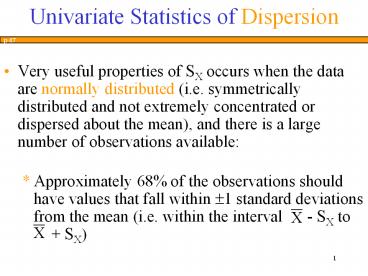Univariate Statistics of Dispersion PowerPoint PPT Presentation
1 / 11
Title: Univariate Statistics of Dispersion
1
Univariate Statistics of Dispersion
p 47
- Very useful properties of SX occurs when the data
are normally distributed (i.e. symmetrically
distributed and not extremely concentrated or
dispersed about the mean), and there is a large
number of observations available - Approximately 68 of the observations should have
values that fall within ?1 standard deviations
from the mean (i.e. within the interval - SX
to ( SX)
2
Univariate Statistics of Dispersion
p 47
- Approximately 95 of the observations should have
values that fall within ?2 standard deviations
from the mean (i.e. within the interval - 2SX
to ( 2SX)
3
Univariate Statistics of Dispersion
p 47
- The variance (S2X) is the square of the standard
deviation -
(3.7)
4
Univariate Statistics of Dispersion
p 47
- It provides the same information about the
variable of interest contained in the standard
deviation, but it is often used as the main
measure of dispersion in statistics - The numerator in the variance is
considered a measure of the total variation in
5
Linear Transformations
- In applied statistics, sometimes is convenient to
define and create a new variable as a
transformation of an existing one, i.e. - Yi f(Xi) for all i
6
Linear Transformations
- If we know and SX, and the transformation is
linear, there is a simple way to calculate and
SY directly from and SX for instance if - Yi a bXi for all i, then
- a b
7
Linear Transformations
- In addition
- S2Y b2S2X and SY bSX
8
Bivariate Statistics
p 53
- The ultimate objective of regression analysis is
to determine if and how certain (independent)
variables influence another (dependent) variable - Bivariate statistics can be used to examine the
degree in which two variables are related,
without implying that one causes the other
9
Bivariate Statistics
p 54
- In Figure 3.3 (a) Y and X are positively but
weakly correlated while in 3.3 (b) they are
negatively and strongly correlated
10
Bivariate Statistics Covariance
p 53
- The covariance is one measure of how closely the
values taken by two variables Y and X vary
together -
(3.17) - A disadvantage of the covariance statistic is
that its magnitude can not be easily interpreted,
since it depends on the units in which we measure
Y and X
11
Bivariate Statistics Correlation Coefficient
p 54
- The related and more used correlation coefficient
remedies this disadvantage by standardizing the
deviations from the mean -
(3.18)

